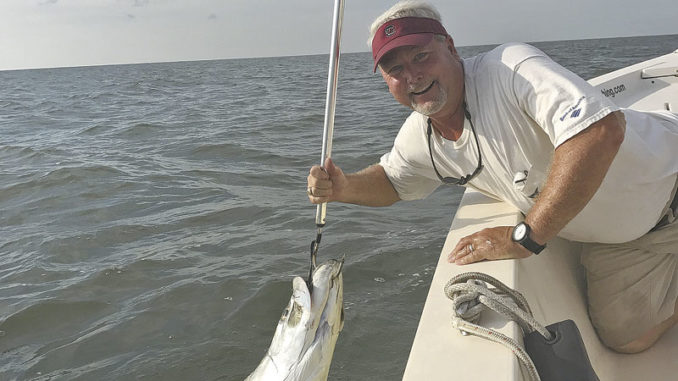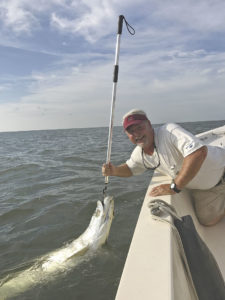
Find the bait, and the silver king will be nearby
August is tarpon time in the waters of South Carolina’s Lowcountry. The fish are plentiful this time of year, and as long as you can find the bait, you’ll stay on the tarpon.
Capt. Rob Bennett of Lowcountry Inshore Charters in Charleston, S.C., said Deveaux Bank and St. Helena Sound are hotspots for the silver kings in August.
“The menhaden schools are thick and easy to spot, and if you are too far away to see the schools from the boat, just keep a lookout for the tarpon rolling in them,” said Bennett (843-367-3777). “When the wind is right, you can drift right alongside those schools of menhaden and put four lines out. I like to have two baits on the surface and two lines on the bottom. The tarpon stay with those schools. So if you just stay on them, too, you’ll be in the right place.”
Matching the hatch is always a good choice for anglers. And Bennett said that’s even more true when tarpon fishing, especially when anglers are fishing around baitfish. He uses live menhaden fresh from those big schools. Since they are so plentiful and easy to catch, he said anglers should make sure their bait stays lively.
If you can’t find the big menhaden schools, or if you just prefer anchoring down, Bennett said you’ll find plenty of tarpon on sandbars in those same areas.
Chumming always helps

“Those shallow sandbars will have tarpon, even in water as shallow as 3 to 6 feet deep,” he said. “The trick to anchoring for tarpon is to keep a constant stream of chum out. Keep it fresh. Just use chunks of herring or menhaden.”
One downside to this kind of fishing, at least in some anglers’ minds, is that you’ll have to weed through some sharks to hook up with a tarpon. But Bennett said that can be just as exciting to many folks. He suggests using a buoy on your anchor rope so once you hook up with either a tarpon or a shark, you can leave your anchor behind while chasing the fish. That allows you to quickly find your anchor once the fight is over.
For tackle, Bennett uses stout rods paired with 6500 series spinning reels, 100-pound braided line, and a 6-foot leader of 100-pound fluorocarbon. He finishes it off with an 8/0 circle hook. He said as long as the tide is moving in either direction, tarpon will be active, but he finds a little more success on the incoming tide.

